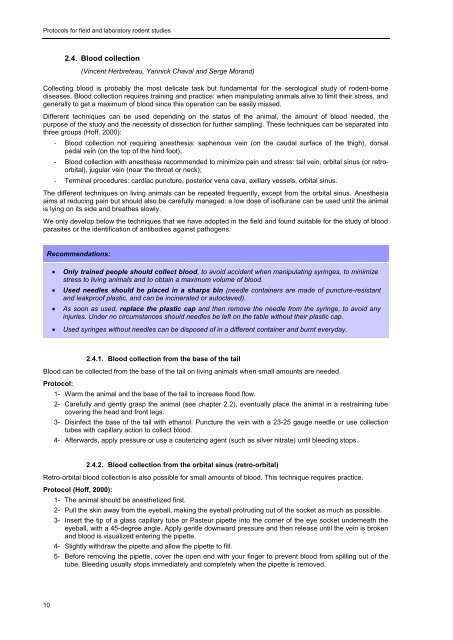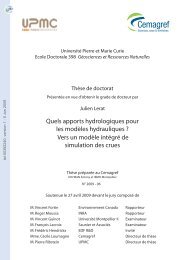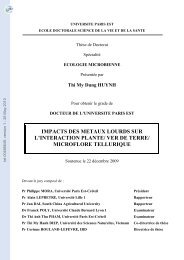Protocols for field and laboratory rodent studies - HAL
Protocols for field and laboratory rodent studies - HAL
Protocols for field and laboratory rodent studies - HAL
- No tags were found...
Create successful ePaper yourself
Turn your PDF publications into a flip-book with our unique Google optimized e-Paper software.
<strong>Protocols</strong> <strong>for</strong> <strong>field</strong> <strong>and</strong> <strong>laboratory</strong> <strong>rodent</strong> <strong>studies</strong>2.4. Blood collection(Vincent Herbreteau, Yannick Chaval <strong>and</strong> Serge Mor<strong>and</strong>)Collecting blood is probably the most delicate task but fundamental <strong>for</strong> the serological study of <strong>rodent</strong>-bornediseases. Blood collection requires training <strong>and</strong> practice: when manipulating animals alive to limit their stress, <strong>and</strong>generally to get a maximum of blood since this operation can be easily missed.Different techniques can be used depending on the status of the animal, the amount of blood needed, thepurpose of the study <strong>and</strong> the necessity of dissection <strong>for</strong> further sampling. These techniques can be separated intothree groups (Hoff, 2000):- Blood collection not requiring anesthesia: saphenous vein (on the caudal surface of the thigh), dorsalpedal vein (on the top of the hind foot);- Blood collection with anesthesia recommended to minimize pain <strong>and</strong> stress: tail vein, orbital sinus (or retroorbital),jugular vein (near the throat or neck);- Terminal procedures: cardiac puncture, posterior vena cava, axillary vessels, orbital sinus.The different techniques on living animals can be repeated frequently, except from the orbital sinus. Anesthesiaaims at reducing pain but should also be carefully managed: a low dose of isoflurane can be used until the animalis lying on its side <strong>and</strong> breathes slowly.We only develop below the techniques that we have adopted in the <strong>field</strong> <strong>and</strong> found suitable <strong>for</strong> the study of bloodparasites or the identification of antibodies against pathogens.Recommendations:Only trained people should collect blood, to avoid accident when manipulating syringes, to minimizestress to living animals <strong>and</strong> to obtain a maximum volume of blood.Used needles should be placed in a sharps bin (needle containers are made of puncture-resistant<strong>and</strong> leakproof plastic, <strong>and</strong> can be incinerated or autoclaved).As soon as used, replace the plastic cap <strong>and</strong> then remove the needle from the syringe, to avoid anyinjuries. Under no circumstances should needles be left on the table without their plastic cap.Used syringes without needles can be disposed of in a different container <strong>and</strong> burnt everyday.2.4.1. Blood collection from the base of the tailBlood can be collected from the base of the tail on living animals when small amounts are needed.Protocol:1- Warm the animal <strong>and</strong> the base of the tail to increase flood flow.2- Carefully <strong>and</strong> gently grasp the animal (see chapter 2.2), eventually place the animal in a restraining tubecovering the head <strong>and</strong> front legs.3- Disinfect the base of the tail with ethanol. Puncture the vein with a 23-25 gauge needle or use collectiontubes with capillary action to collect blood.4- Afterwards, apply pressure or use a cauterizing agent (such as silver nitrate) until bleeding stops.2.4.2. Blood collection from the orbital sinus (retro-orbital)Retro-orbital blood collection is also possible <strong>for</strong> small amounts of blood. This technique requires practice.Protocol (Hoff, 2000):1- The animal should be anesthetized first.2- Pull the skin away from the eyeball, making the eyeball protruding out of the socket as much as possible.3- Insert the tip of a glass capillary tube or Pasteur pipette into the corner of the eye socket underneath theeyeball, with a 45-degree angle. Apply gentle downward pressure <strong>and</strong> then release until the vein is broken<strong>and</strong> blood is visualized entering the pipette.4- Slightly withdraw the pipette <strong>and</strong> allow the pipette to fill.5- Be<strong>for</strong>e removing the pipette, cover the open end with your finger to prevent blood from spilling out of thetube. Bleeding usually stops immediately <strong>and</strong> completely when the pipette is removed.10
















